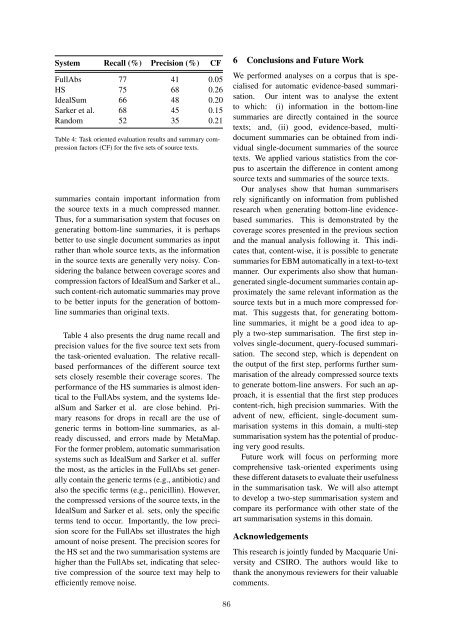Full proceedings volume - Australasian Language Technology ...
Full proceedings volume - Australasian Language Technology ...
Full proceedings volume - Australasian Language Technology ...
You also want an ePaper? Increase the reach of your titles
YUMPU automatically turns print PDFs into web optimized ePapers that Google loves.
System Recall (%) Precision (%) CF<br />
<strong>Full</strong>Abs 77 41 0.05<br />
HS 75 68 0.26<br />
IdealSum 66 48 0.20<br />
Sarker et al. 68 45 0.15<br />
Random 52 35 0.21<br />
Table 4: Task oriented evaluation results and summary compression<br />
factors (CF) for the five sets of source texts.<br />
summaries contain important information from<br />
the source texts in a much compressed manner.<br />
Thus, for a summarisation system that focuses on<br />
generating bottom-line summaries, it is perhaps<br />
better to use single document summaries as input<br />
rather than whole source texts, as the information<br />
in the source texts are generally very noisy. Considering<br />
the balance between coverage scores and<br />
compression factors of IdealSum and Sarker et al.,<br />
such content-rich automatic summaries may prove<br />
to be better inputs for the generation of bottomline<br />
summaries than original texts.<br />
Table 4 also presents the drug name recall and<br />
precision values for the five source text sets from<br />
the task-oriented evaluation. The relative recallbased<br />
performances of the different source text<br />
sets closely resemble their coverage scores. The<br />
performance of the HS summaries is almost identical<br />
to the <strong>Full</strong>Abs system, and the systems IdealSum<br />
and Sarker et al. are close behind. Primary<br />
reasons for drops in recall are the use of<br />
generic terms in bottom-line summaries, as already<br />
discussed, and errors made by MetaMap.<br />
For the former problem, automatic summarisation<br />
systems such as IdealSum and Sarker et al. suffer<br />
the most, as the articles in the <strong>Full</strong>Abs set generally<br />
contain the generic terms (e.g., antibiotic) and<br />
also the specific terms (e.g., penicillin). However,<br />
the compressed versions of the source texts, in the<br />
IdealSum and Sarker et al. sets, only the specific<br />
terms tend to occur. Importantly, the low precision<br />
score for the <strong>Full</strong>Abs set illustrates the high<br />
amount of noise present. The precision scores for<br />
the HS set and the two summarisation systems are<br />
higher than the <strong>Full</strong>Abs set, indicating that selective<br />
compression of the source text may help to<br />
efficiently remove noise.<br />
6 Conclusions and Future Work<br />
We performed analyses on a corpus that is specialised<br />
for automatic evidence-based summarisation.<br />
Our intent was to analyse the extent<br />
to which: (i) information in the bottom-line<br />
summaries are directly contained in the source<br />
texts; and, (ii) good, evidence-based, multidocument<br />
summaries can be obtained from individual<br />
single-document summaries of the source<br />
texts. We applied various statistics from the corpus<br />
to ascertain the difference in content among<br />
source texts and summaries of the source texts.<br />
Our analyses show that human summarisers<br />
rely significantly on information from published<br />
research when generating bottom-line evidencebased<br />
summaries. This is demonstrated by the<br />
coverage scores presented in the previous section<br />
and the manual analysis following it. This indicates<br />
that, content-wise, it is possible to generate<br />
summaries for EBM automatically in a text-to-text<br />
manner. Our experiments also show that humangenerated<br />
single-document summaries contain approximately<br />
the same relevant information as the<br />
source texts but in a much more compressed format.<br />
This suggests that, for generating bottomline<br />
summaries, it might be a good idea to apply<br />
a two-step summarisation. The first step involves<br />
single-document, query-focused summarisation.<br />
The second step, which is dependent on<br />
the output of the first step, performs further summarisation<br />
of the already compressed source texts<br />
to generate bottom-line answers. For such an approach,<br />
it is essential that the first step produces<br />
content-rich, high precision summaries. With the<br />
advent of new, efficient, single-document summarisation<br />
systems in this domain, a multi-step<br />
summarisation system has the potential of producing<br />
very good results.<br />
Future work will focus on performing more<br />
comprehensive task-oriented experiments using<br />
these different datasets to evaluate their usefulness<br />
in the summarisation task. We will also attempt<br />
to develop a two-step summarisation system and<br />
compare its performance with other state of the<br />
art summarisation systems in this domain.<br />
Acknowledgements<br />
This research is jointly funded by Macquarie University<br />
and CSIRO. The authors would like to<br />
thank the anonymous reviewers for their valuable<br />
comments.<br />
86














